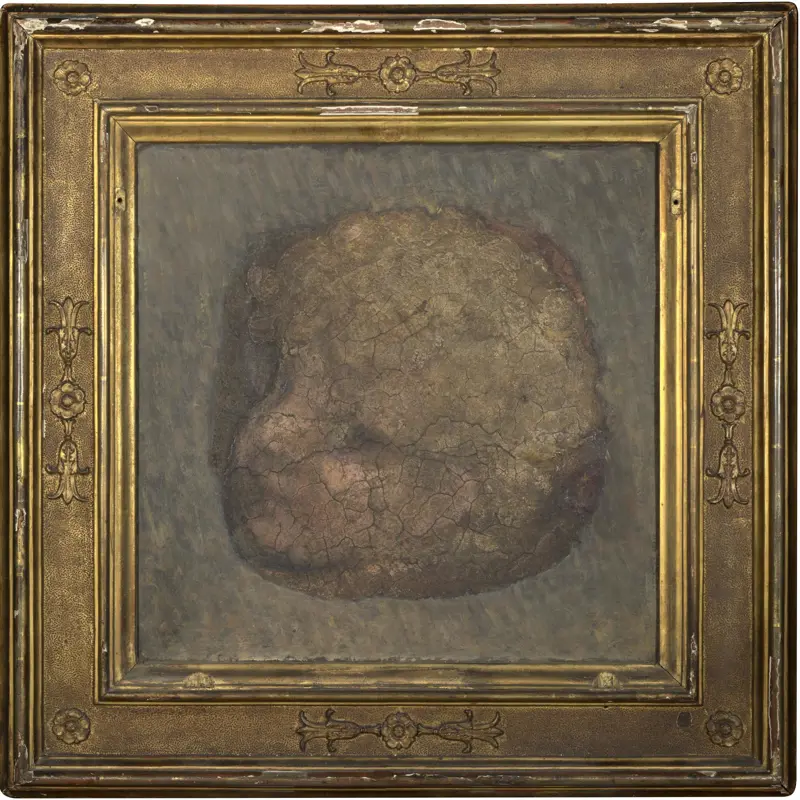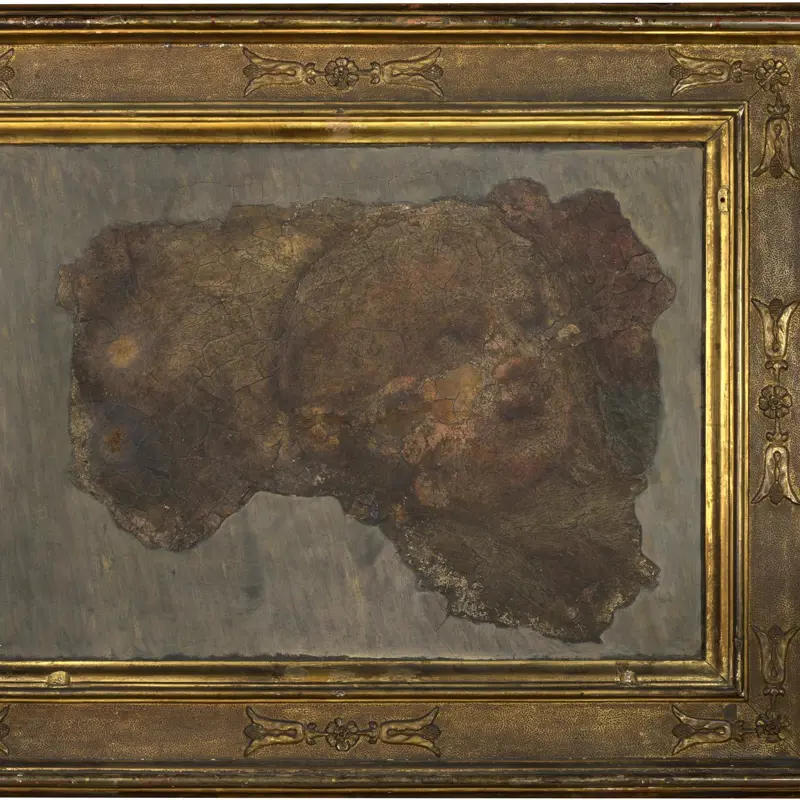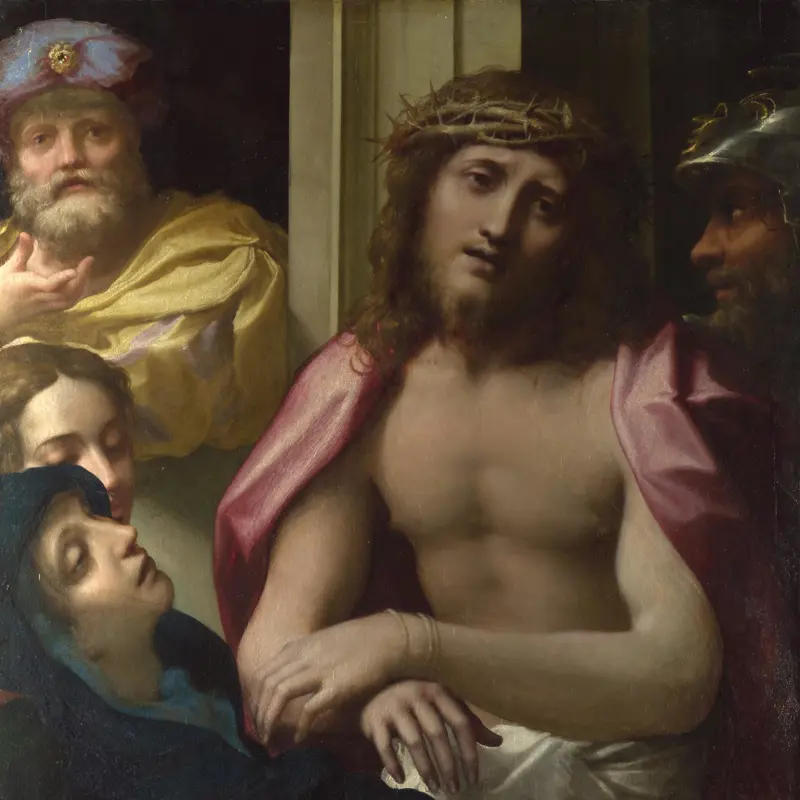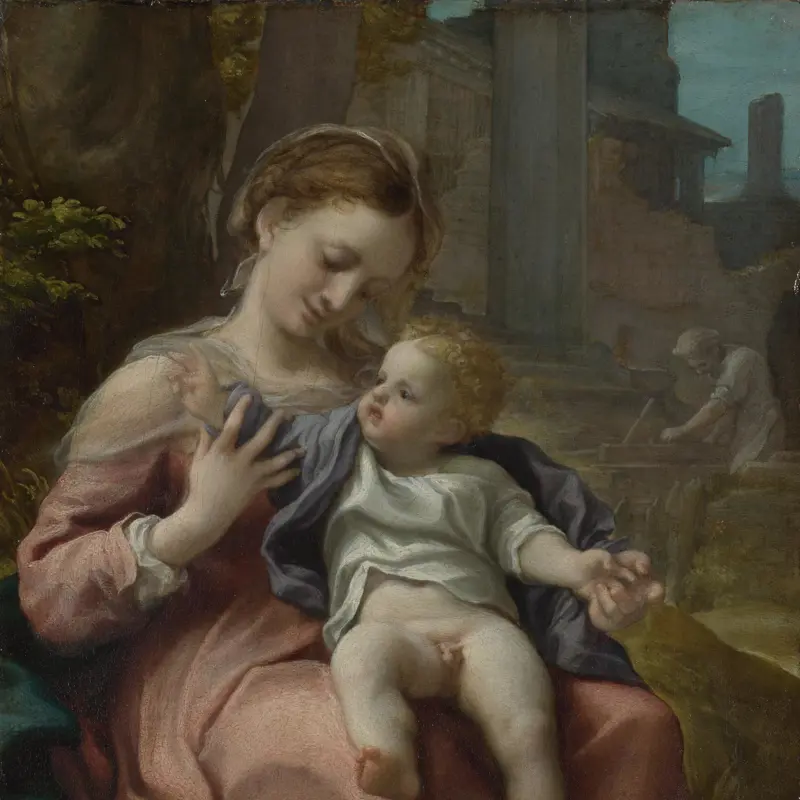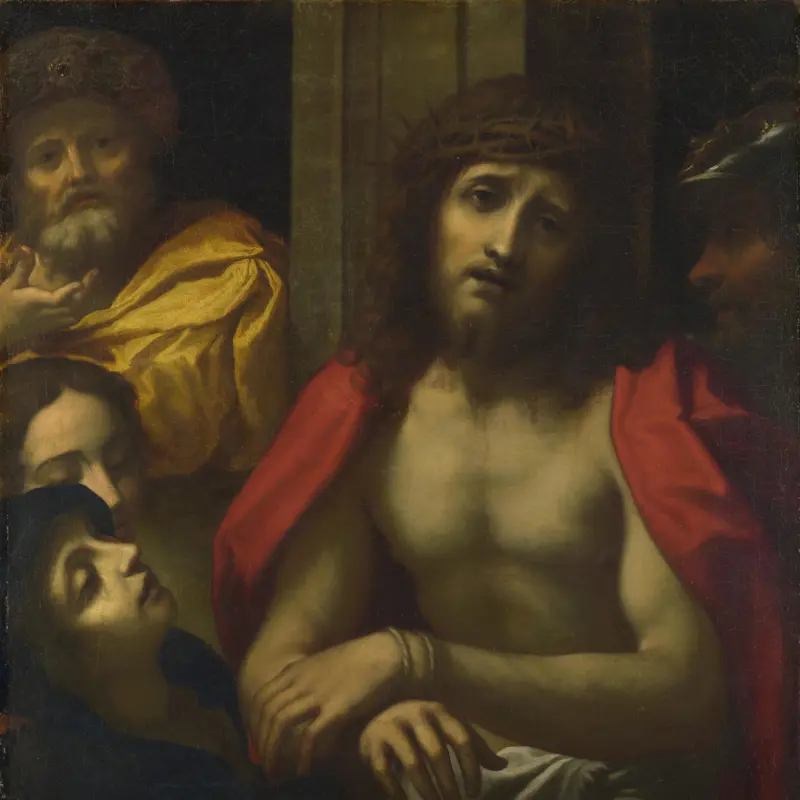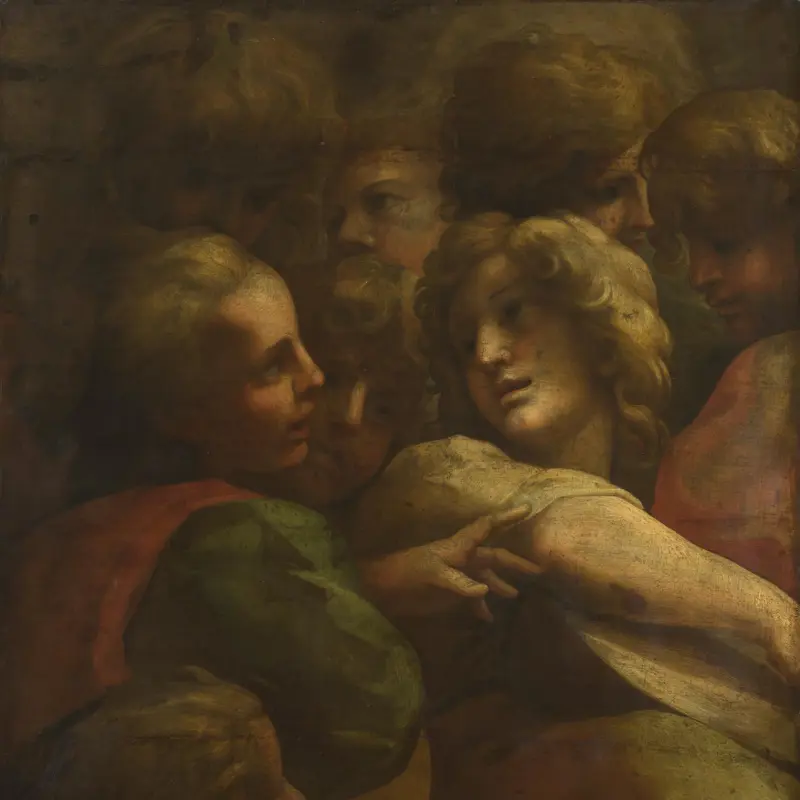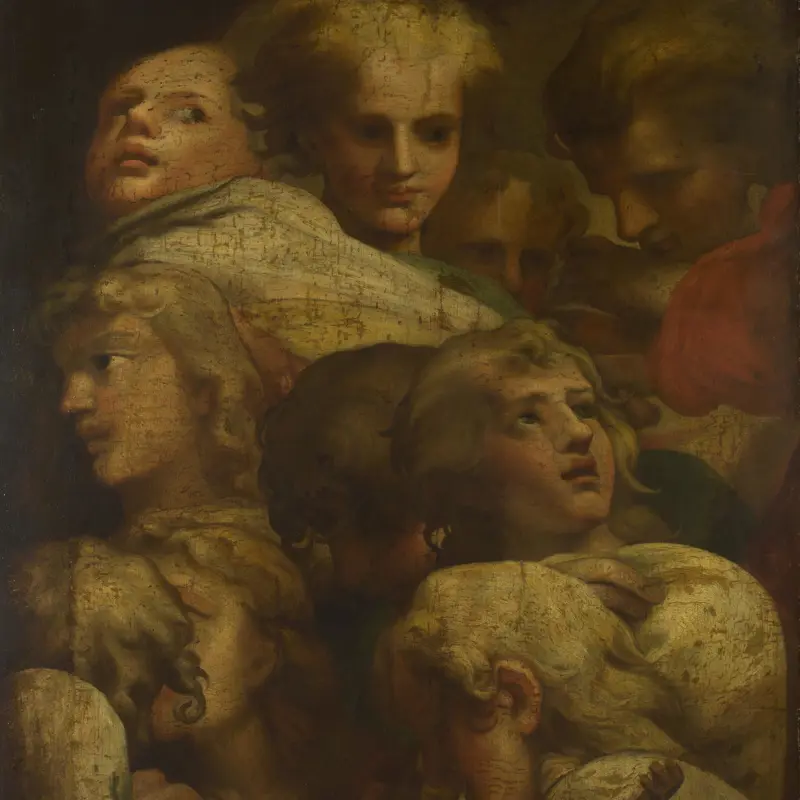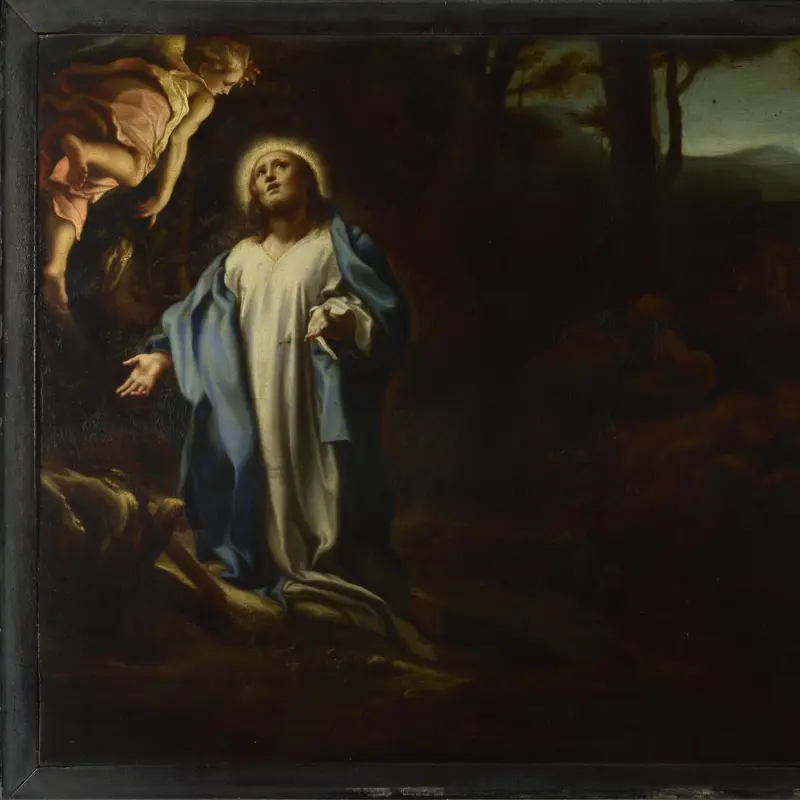Correggio, 'Head of an Angel', probably about 1522
About the work
Overview
This is a fresco fragment from Correggio’s Coronation of the Virgin, which he painted in the apse of the church of S. Giovanni Evangelista in Parma. The fresco depicted Christ crowning the Virgin Mary in heaven, surrounded by the evangelists, doctors of the church and infant angels. Christ and the Virgin were seated beneath a flowering garden pergola against the golden sun of paradise .
This head belonged to the angel reclining on a cloud at the feet of Saint John the Evangelist sitting to the left of the Virgin. The angel is looking back over his shoulder at us.
The apse of the church was destroyed in the 1580s but the central figures showing the coronation of the Virgin were saved and are in the Galleria Nazionale, Parma.
Key facts
Details
- Full title
- Head of an Angel
- Artist
- Correggio
- Artist dates
- Active 1494, died 1534
- Part of the series
- Fragments from The Coronation of the Virgin
- Date made
- Probably about 1522
- Medium and support
- Fresco
- Dimensions
- 35.6 × 35.6 cm
- Acquisition credit
- Mond Bequest, 1924
- Inventory number
- NG3920
- Location
- Not on display
- Collection
- Main Collection
Provenance
Additional information
Text extracted from the ‘Provenance’ section of the catalogue entry in Cecil Gould, ‘National Gallery Catalogues: The Sixteenth Century Italian Schools’, London 1987; for further information, see the full catalogue entry.
Bibliography
-
1760G.P. Rossini, Il Mercurio errante della grandezze di Roma, tanto antiche che moderne, Rome 1760
-
1781G. Tiraboschi, Biblioteca modenese, Modena 1781
-
1787A.R. Mengs, Opere di Antonio Raffaello Mengs, Rome 1787
-
1797G.A. Vasi, Itinéraire instructif de Rome, Rome 1797
-
1822L.A. Lanzi, Storia pittorica della italia dal risorgimento delle belle arti fin presso al fine del XVIII secolo, Florence 1822
-
1854G.F. Waagen, Treasures of Art in Great Britain: Being and Account of the Chief Collections of Paintings, Drawings, Sculptures, Illuminated Mss. […], vol. 2, trans. E. Eastlake, London 1854
-
1896C. Ricci, Antonio Allegri da Correggio, London 1896
-
1910J.P. Richter, The Mond Collection: An Appreciation, London 1910
-
1924A. Venturi, 'La quadreria di Ludwig Mond', L'arte, XXVII, 1924, pp. 200-10
-
1930C. Ricci, Correggio, London 1930
-
1937A.O. Quintavalle, 'Un disegno del Correggio scoperto nello stacco dell'affresco dell'Incoronata', Bollettino d'arte, XXXI/3, 1937, pp. 80-8
-
1953P. Bianconi, Tutta la pittura del Correggio, Milan 1953
-
1962Gould, Cecil, National Gallery Catalogues: The Sixteenth Century Italian Schools (excluding the Venetian), London 1962
-
1962A.G. Quintavalle, Correggio in San Giovanni Evangelista, Milan 1962
-
1965A.G. Quintavalle, 'Ignorati affreschi del Correggio in San Giovanni Evangelista a Parma', Bollettino d'arte, L/5, 1965, pp. 193-9
-
1968A.G. Quintavalle, 'L'incoronata del Correggio', Bollettino d'arte, 1968
-
1974G.M. Toscano, Nuovi studi sul Correggio, Parma 1974
-
1975C. Gould, Delaroche and Gautier: Gautier's Views on the 'Execution of Lady Jane Grey' and on other Compositions by Delaroche, London 1975
-
1976C. Gould, The Paintings of Correggio, London 1976
-
1976G.D. Wind, 'The Benedictine Program of S. Giovanni Evangelista in Parma', Art Bulletin, LVIII/4, 1976, pp. 521-7
-
1977D.A. Brown, 'A New Book on Correggio', The Burlington Magazine, CXIX/897, 1977, pp. 860-1
-
1977J. Pope-Hennessy, 'Correggio Revalued', Apollo, CVI, 1977
-
1977J. Shearman, 'Correggio and the Connoisseurs', Times Literary Supplement, 1977
-
1978F. Büttner, 'Review: Gould, the Paintings of Correggio, London, 1976', Kunstchronik, XXXI, 1978, pp. 206-7
-
1979E. Battisti, L'abbazia benedettina di san Giovanni evangelista a Parma, ed. B. Adoni, Parma 1979
-
1979E.J. Olszewski, 'Review of Gould', Art Journal, XXXVIII, 1979
-
1982G. Ercoli, Arte e fortuna del Correggio, Modena 1982
-
1987Gould, Cecil, National Gallery Catalogues: The Sixteenth Century Italian Schools, London 1987
-
1989P.P. Mendogni, Il Correggio a Parma, Parma 1989
-
1993M. Di Giampaolo and A. Muzzi, Correggio: Catalogo completo dei dipinti, Florence 1993
-
2001
C. Baker and T. Henry, The National Gallery: Complete Illustrated Catalogue, London 2001
About this record
If you know more about this work or have spotted an error, please contact us. Please note that exhibition histories are listed from 2009 onwards. Bibliographies may not be complete; more comprehensive information is available in the National Gallery Library.
Images
About the series: Fragments from The Coronation of the Virgin
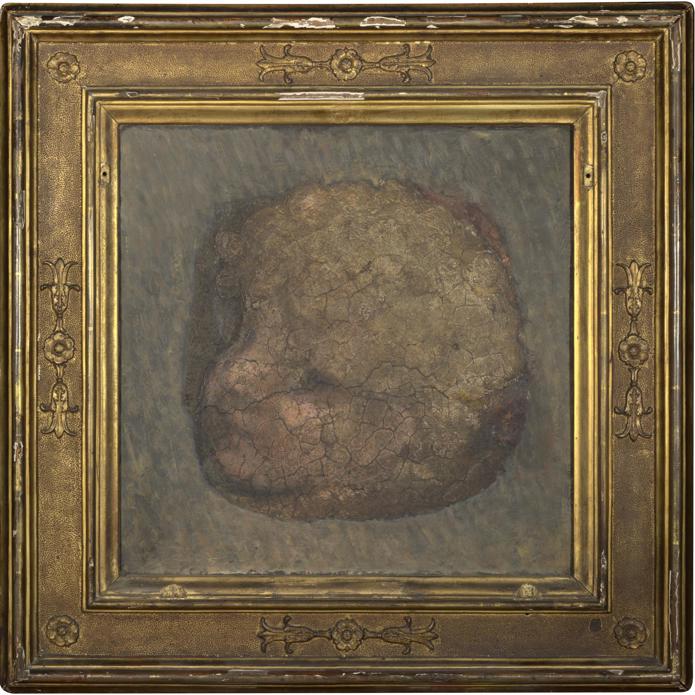
Overview
These are fresco fragments from Correggio’s Coronation of the Virgin, which once decorated the apse of the church of S. Giovanni Evangelista in Parma. The fresco depicted Christ crowning the Virgin Mary in paradise surrounded by the evangelists and doctors of the church, and baby angels known in Italian as putti.
The Virgin was the principal patron saint of Parma and the coronation of the Virgin was depicted on the city’s seal as well as its coinage. A coin of 1526 shows a design particularly close to Correggio’s Coronation of the Virgin, suggesting that his fresco had an immediate impact on the city.
The apse was destroyed when the choir was enlarged, but the heads of angels were saved and are now in the National Gallery. The central figures showing Christ and the Virgin are now in the Galleria Nazionale, Parma. In 1587 a replica of Correggio’s fresco was painted in the new apse of S. Giovanni Evangelista.

